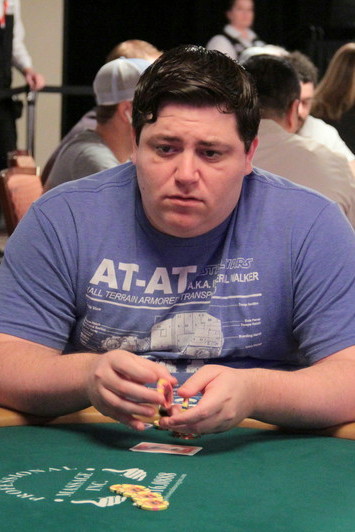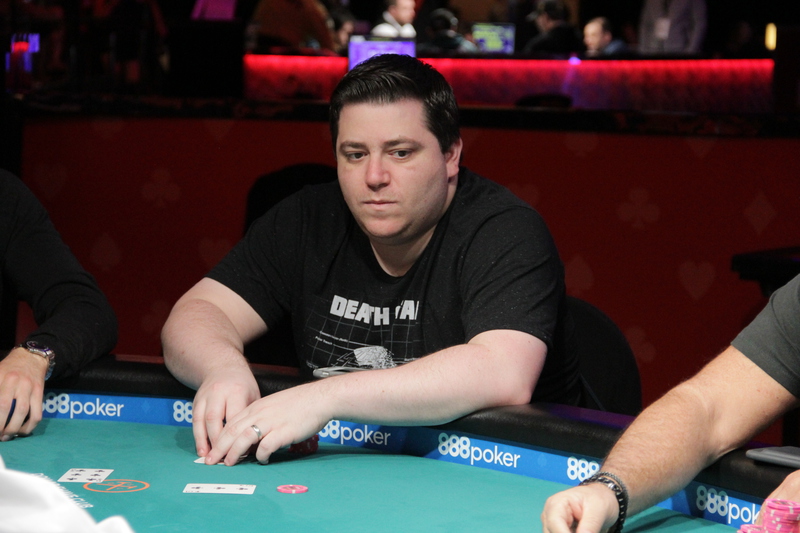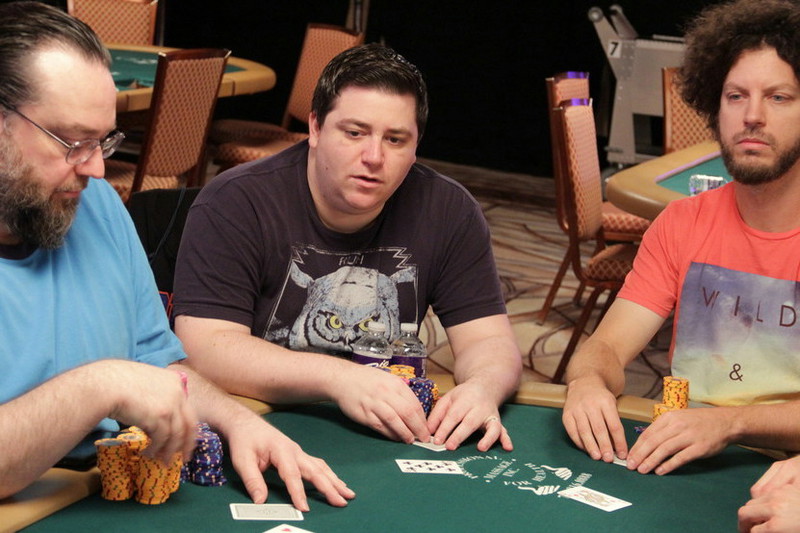
The World Series of Poker brings out all of poker’s most talented pros to compete for hundreds of thousands, if not millions of dollars over the course of seven weeks.
It’s also the one time throughout the year that many of the game’s best aren’t playing no-limit hold’em. Throughout the summer, high-stakes mixed games tournaments are front and center in the poker world.
In an effort to provide readers with solid fundamental strategy of mixed games, Card Player sat down with Randy Ohel, a regular in these events, to discuss the concept of ‘snowing,’ or bluffing, in draw games.
Ohel, who has a bracelet in triple draw and WSOP final tables in several other poker variants, broke down a hand from the final table of the $10,000 no-limit 2-7 single draw event in which Prahlad Friedman picked off Darren Elias’ attempt to snow the former online poker legend.
The Hand
| Event-Blinds | 2019 WSOP $10K NL 2-7 Single Draw | 10,000-25,000 With A 35,000 Big Blind Ante |
| Players | Prahlad Friedman | Darren Elias |
| Chip Count | 1,050,000 | 1,080,000 |
| Hand | 10-6-5-4-4 | A-6-6-2-2 |
Four-handed at the final table, Darren Elias raised to 100,000 from the small blind and Prahlad Friedman called from the big blind. Elias stood pat and Friedman drew one.
After the draw, Elias bet 150,000 and Friedman tanked for several minutes before calling. Elias was snowing (bluffing) with two pair in a lowball game and Friedman made an amazing hero call with a pair of fours.
Steve Schult: In most big bet tournaments, we’ve seen a trend towards smaller raise sizes. Is that different in this game? Why is Elias making it four times the blind here?
Randy Ohel: In single draw, all your sizings are going to be bigger. Whether its pre-draw, whether it’s the opening raise, whether it’s three-betting, whether it’s betting or raising after the draw, everything is bigger. Because there’s only two streets to get value, and also only two streets to bluff.
You don’t have that hammer of the next street that you can bluff a guy with or threaten a guy with. So every sizing is bigger, and also pre-draw equities are often fairly close, so you have to make a big raise whether it’s to price them out or make them pay to draw. In this case, Darren was going to be out of position from the small blind. Just like in no-limit hold’em, you always size up from the small blind against the big blind. So even if his standard might have been three, he makes it four in that situation.
SS: Prahlad takes one and is drawing to a ten. How wide is he going to be defending against the small blind? Will he have two-card draws? Or is it going to depend on what Darren does?
 RO: Blind on blind you’re definitely going to be defending two-card draws. Any eight-draw that doesn’t have a straight draw and any seven-draw that doesn’t have a straight draw. And basically any one-card draw that is ten or better that doesn’t have a straight draw. Also, some nines with gutshots, eights with gutshots and sevens with gutshots.
RO: Blind on blind you’re definitely going to be defending two-card draws. Any eight-draw that doesn’t have a straight draw and any seven-draw that doesn’t have a straight draw. And basically any one-card draw that is ten or better that doesn’t have a straight draw. Also, some nines with gutshots, eights with gutshots and sevens with gutshots.
SS: Darren decides to stand pat. In this game, since snowing is such a big part of it, would he ever throw away the ace and keep the two pair? Would that make it look like less of a snow?
RO: That actually happened once at this particular final table, but it is incredibly uncommon in single draw. Because in single draw, it’s very common to bluff with a pair on the end anyway. So when you draw one, you’re much more likely to be bluffing than when you’re pat after you bet on the end.
In triple draw, going one, zero, zero is a common snow line with two pair or whatever. But in single draw, it’s very uncommon to draw intending to snow because you so often get caught bluffing anyway.
SS: What types of hands would Prahlad three-bet from this position if a one-card draw to a ten isn’t good enough?
RO: Convertibles….
SS: What are convertibles?
RO: It’s a hand that you can play either as a draw or a pat hand depending on what your opponent does. So, convertibles, strong draws, and all pats. Especially draws with a pair because it’s better to have a blocker.
It’s better to have 2-2-3-4-7 instead of K-7-4-3-2. Because you are pitching one either way and you’re blocking one when you have the pair.
SS: You said equities run close together. Is a hand like a one-card wheel draw stronger than a pat ten or jack or something?
RO: It’s an equity dog, but it certainly has better implied odds, especially when you’re in position. It’s much better implied odds to have a better draw than a shitty pat hand. With a shitty pat hand, you have the equity edge with the implied odds disadvantage.
SS: When he bets after the draw, after standing pat against a one-card draw, he’s representing a very narrow, strong range, right?
RO: In a battle of the blinds, his range to bet there is probably all nines or better and maybe the best of his tens. Plus his snows, obviously. Maybe he’s check-raising some super strong hands as well, and probably is.
SS: How big are live tells in this game? There’s only so much information to be had, is there more of a ‘feel’ aspect to it?
RO: They’re huge. They’re so huge. I think I may have said this on the broadcast. It’s the most artistic form of poker there is. It is a game that really combines game theory and all of that stuff, but with an incredible amount of live tells.

If you think he’s bluffing that is. And if you think he has it, it doesn’t matter that you have this great bluff catcher that’s at the top of your range that can’t beat value. If it just looks like he has it, you might just have to fold. But in the absence of that type of information, that’s when we revert to all the game theory stuff.
But yes, there is a ton of art and tells to it. More than any other form of poker, I’ve described it as, ‘stare at the guy and see if he’s got it or not.’
SS: With Darren’s snow, he had two of the sixes. Since a six isn’t a wheel card, does that matter as much in single draw? In triple draw, I know it’s better to snow with wheel cards because of the stronger showdown range that comes from multiple draws.
RO: Any card nine or better is a snow blocker for sure. You’re not representing a wheel when you bet and you’re not worried about a wheel. So that’s not relevant at all. Just having cards generally nine or better are the ones that you need to have to snow. That could be eights full of nines (8-8-8-9-9) and that’s almost as powerful as like sevens full of fives (7-7-7-5-5) or something.
SS: Is Darren ever going to just give up here?
 RO: No. He wouldn’t have patted if he was going to check-fold.
RO: No. He wouldn’t have patted if he was going to check-fold.
SS: Walk me through what Friedman could have been thinking to call in that spot?
RO: The only thing that I could think of that Prahlad is thinking is… well, there’s two parts to it. One is that maybe he just looked at the guy and thought he didn’t have anything. Like what we were talking about before.
And the other thing is that fours always beat a snow. A pair of fours is the same as like a jack there. Because they can’t beat any value, but they beat all bluffs. Obviously, you can’t just call with all those hands because you are calling way too much, but if it looks like the guy is bluffing, it doesn’t matter if he paired a four or if he made a jack.
SS: Would it be much different if he paired his ten? Could that beat his snows?
RO: He should be able to beat all his snows, really, but pairing his four is an extra blocker for a hand that Darren might value bet. Whereas a pair of tens is not so much.
But really, as long as you have these hands that can beat bluffs but can’t beat value it doesn’t really matter which one it is from a perspective of ‘I have the tell on a guy.’ If it was in the dark, playing online, it is a completely different story.
SS: In terms of learning the game and coming up, is it even possible to play this game online and in the dark? Or is the game too dependent on physical reads to really become great just playing online in this game?
RO: You can develop all your ‘play in a vacuum’ strategies, which are extremely important. To be an expert at something and know how to break the rules at something, you must first know what the rules are. And that is true about everything. Everyone says that about everything. Every science, every art, sports… everything.
So, to really know when to break the rules, you have to know the rules. And in this case, knowing the rules would be the ‘correct’ way to play in a vacuum. Those would be the rules. And deviating from that against opponents because of tells and that sort of thing.
SS: Just to bring it all full circle, what are some good hands to snow in this game? You touched on it earlier with cards lower than nine, but can you be a little more specific?
RO: Combinations of hands that have five cards lower than a nine. Like full houses, trips with kickers, two pair with a kicker or other hands that have an unplayable draw.
